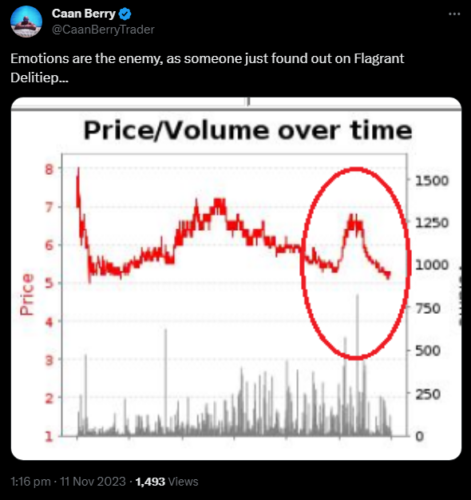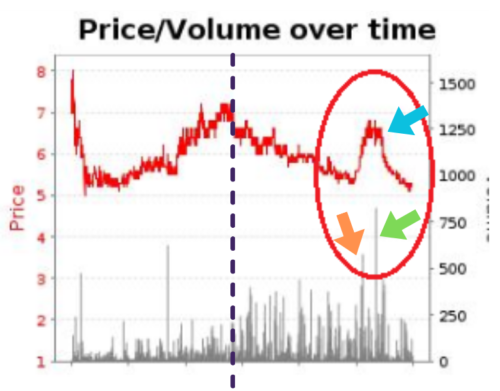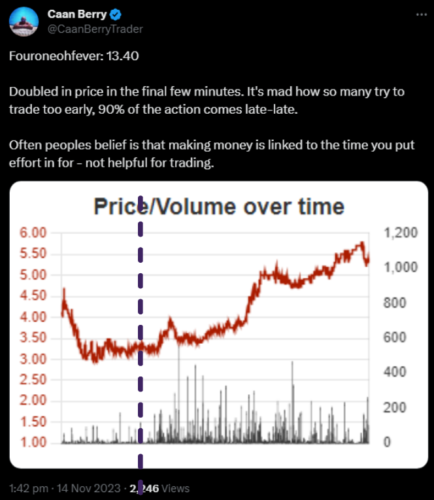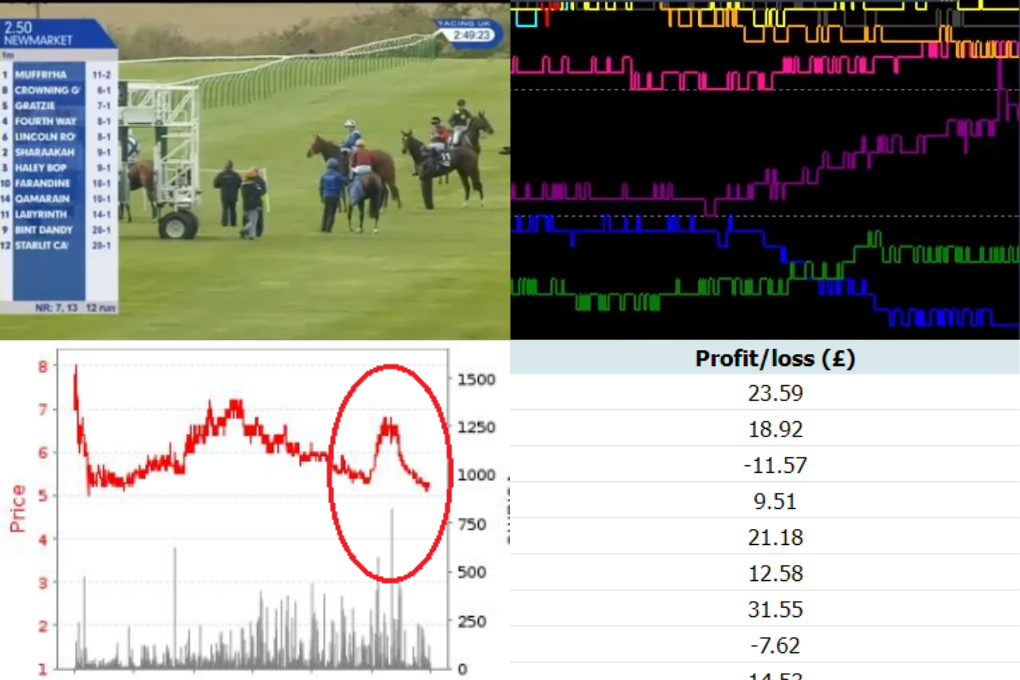What is the most reliable edge in Betfair trading? It’s a good question.
Aside from those beating time delays, I believe what I’m about to share could be it. The penny dropped for me on this one over a decade ago now and it still works.
Even if it isn’t the type of edge you want to pursue, this post will be quite insightful. It could help other Betfair trading edges you have so bear in mind the key dynamics as I drop some strong hints…
An Edge Presenting Itself Over And Over Again
A week or so ago I made the following tweet because it was a good example.
Have you seen a Betfair chart like this before?

It happens pretty regularly, right?
Now ignore my comment about emotion, we’ll come onto that in a second. First, I want to be crystal clear – this happens in just about every betting market. It’s not always as obvious or extreme, but it happens over and over again. Sometimes there are several instances of it happening inside a single live show (the most active betting window).
But why?
There’s a whole list of reasons, emotion and human behaviour being the broadest description as per my comment. I’ll explain the contributing factors more in a moment but the key takeaway here is; that this is happening all the time due to human behaviour and those trading the betting markets for a profit (in multiple contexts).
These instances are perfect setups to make a tidy low-risk profit in horse racing.
Understanding What’s Happening:
So let’s unpack what was going on here and why, it’ll reinforce those important points a little more…
Firstly you may have noticed I said ‘in racing’. That’s not to say this doesn’t happen in multiple sporting markets, it does. However, the nature of horse racing betting makes it somewhat more interesting. Why? Because horse racing prices are more subjective than say, tennis.
In addition to sentiment-driven markets, it’s worth bearing in mind that around 70% of all money traded on the Betfair Exchange is anticipated to be trader’s money.
Now, let’s look at this Betfair trading edge in the eyes of this situation:

Left of the dotted line, we have the betting market history in the lead-up to the last 5 minutes before the race starts (see how there are significantly lower traded volumes). Right of the line is the ‘active window’ where money is flowing into the market at a higher rate, as per the bars.
The circled area shows an aggressive spike in price between 5.3 to 6.8. For clarity; this was another person in the betting market desperately trying to dump their betting position. Prior to the spike, this runner had been steadily steaming in the market attracting a mild level of support.
The orange arrow shows a volume spike where they begin to panic. Marked with a light blue arrow shows the peak of their madness where the market absorbed their stake. The light green arrow denotes their stake being swallowed (clearly they were over-exposed). Afterwards, the price corrects back to its original position.
This whole instance played out in no more than 30 seconds. A painful 30 seconds for whoever was on the other side, although an extremely profitable low-risk 15 seconds for those who backed their exit at 6.8.
Situation, trading time, market type, liquidity and staking all created the perfect storm for a very clear example here but this happens on a far smaller scale again and again. It’s the type of human behaviour that creates those extremely frustrating trading profit and loss sheets. The ones where results are smooth and consistent before wham! a big loss.
Now I’ll explain a little more about those underlying issues…
The Underlying Issue (It’ll Never Change)
I really hope the value within this post isn’t lost on people because this Betfair trading edge isn’t going anywhere soon.
Achieving smooth consistent profit and loss sheets comes from applying logic to the market madness. Compared to everyday jobs, trading is counter-intuitive. We can make big sums in extremely short periods of time consistently, it’s not like a normal job. This bias in human perception is also a large reason this edge works so well.
Here’s another comment I made when thinking about writing this post:

The dotted line above clearly shows a change in the market activity – the live show.
Trading the markets before this can certainly be done, although a totally different approach is needed. Betfair scalping before this time period is complete madness, the market is weaker, there’s less turnover and using such a strategy leaves you extremely exposed. There’s a post about the stages of trading time on Betfair here for after you’ve read this post.
Why do I mention this?
Because overall situation, market type and timing are crucial in trading. We want to limit risk and maximise potential (a bit like backing at 6.8 in the previous example). Trading too early, using stakes that don’t fit (see previous example also) and being greedy, emotional or impatient result in pain every time.
The underlying issue is human behaviour and perception. Alter yours and it’ll get a lot easier, watch others in the market and you’ll make some money from it. However, if you ignore these things, you’ll probably be looking at another one of those chunky losses soon.
It reminds me of a Buffet quote…



10 thoughts on “The Most Reliable Edge in Betfair Trading?”
Caan, I appreciate your openness in sharing this. I’ve been engaged in Betfair trading for roughly 18 months, and this is the most insightful article I’ve come across regarding pre-race trading. You’re a gem – thank you immensely! EM
No problems, don’t forget it! This happens over and over again in every market. On a far smaller scale it provides value regularly too, you don’t have to get a point and a halfs move every time!
Picking up on your comment about the high level of traders money on Betfair (an estimated 70% of all trades), I have often wondered about how much “sticky” money ie “at risk” bets there are in the matched bets figures I see in Betfair Live. It is common to see a matched bets % for a starter (particularly the favourite) well in excess of its win probability %. Given the disparity between the level of betting and the odds, it is clear that trading makes up a high proportion of the matched bets figure (or the price would move under weight of money) but I hadn’t expected it to be as high as 70%. Going back to my original question, in your experience, does trading generate much “at risk” betting or is it more or less a zero sum game (give or take the margin the traders are looking to earn)? If it’s the latter, I can heavily discount or ignore the matched bets figures when weighing up the merits of my selections.
The 70% was a remark made by somone at Betfair years ago. It depends on the race quality, event and TV coverage but there’s still a lot of ‘at risk money’ as you put it. Of the 70%, there are traders like you and I, arbitrage players and bookies heding too (sure there’s many other groups to mention but you get the point).
What is to say it was somebody panicking? Why couldn’t it have been somebody very successfully watching the market, seeing it got to 5.3 and laying a load of money, and then backing at 6.8 to get some healthy profit?
Through watching the activity on the ladder, I suppose this is the missing thing from this post. The money was chased up after too much was backed at the lower price. Take a look at the traded volume bars! Watching the activity at the touch prices gives a lot away in this regard sometimes. Maybe I’ll have to grab a recording to re-inforce this point.
I can’t stop noticing this now! thanks!!
So how would you approach this trade for the example given? Spot the over reaction and back, then close when the price returns to its trend price ?
Playing devil’s advocate…
What if it was the horse sweating up or playing up in the parade ring or going down? That could easily move a market with access to live pictures just as much as someone trying to dump a position, right? Presumably you would need to be watching pictures to discount the 1st reason.
Or, if the price had started moving outwards and not stopped, it might be a layer with inside information, initiating backing to push the price down and causing a snowball effect from other market parcipants, then pushing in big lays at the lower price to close out their profit?
Yes, always got to have live pictures. Trading without them it to trade blind.